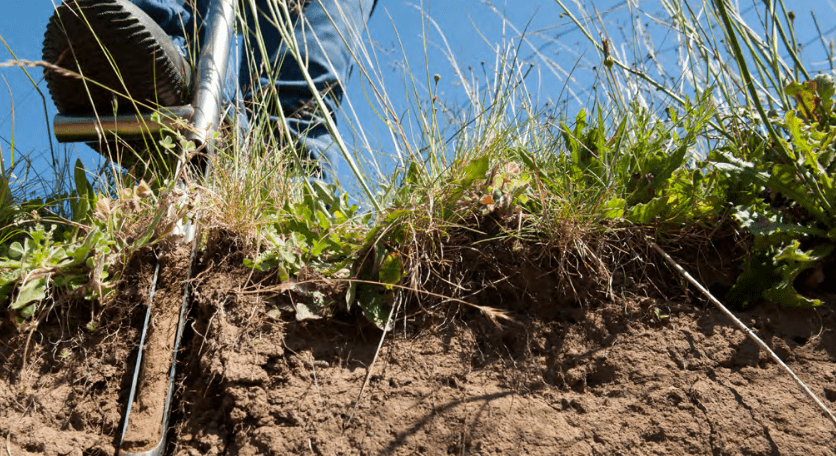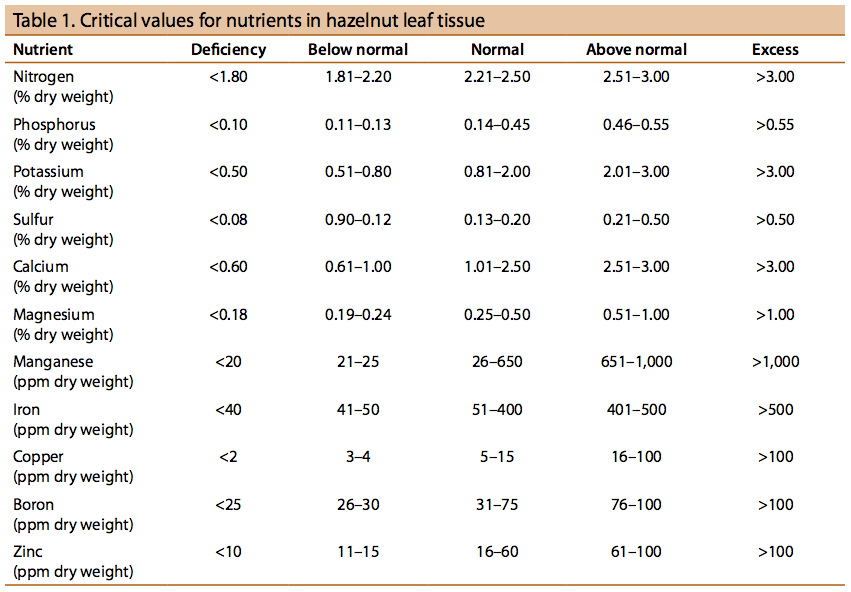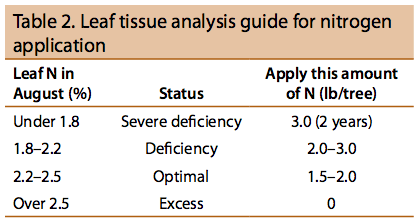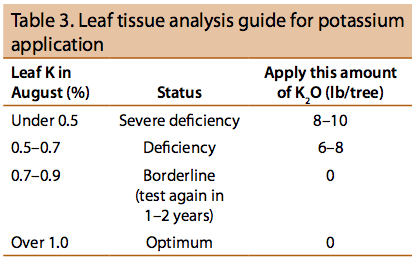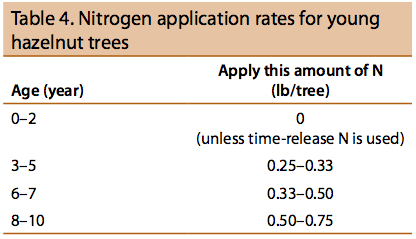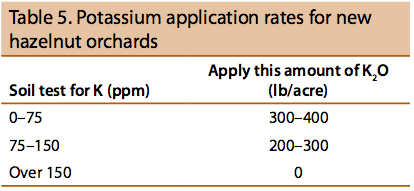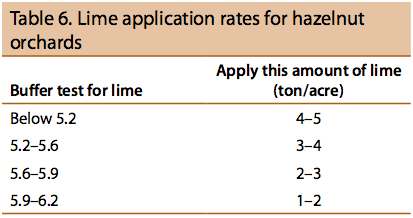A comprehensive approach to nutrient management will help you ensure that optimum nutrient levels are available for tree growth. A comprehensive nutrient management strategy includes the following:
• Soil analysis before planting (useful in predicting the need for potassium, magnesium, or lime applications)
• Observations of annual shoot growth, leaf size and color, and crop yields
• Leaf analysis (to indicate which elements are present in adequate, deficient, or excessive amounts)
• Soil test results in mature orchards (to check for low pH values and evaluate the need for liming)
Suspect a nutrient deficiency if the cause of poor tree performance is not primarily one or more of the following: lack of pruning, winter injury, poor soil drainage, shallow soil, physical injury, disease, insects, poor weather, poor pollination, rodents, or limited moisture.
When applying any fertilizer, read and follow the label directions.
Leaf Tissue Analysis
Soil tests are one piece of the picture for predicting fertilizer needs for established orchards. Leaf tissue analysis provides further information about which elements are present in the trees in adequate, deficient, or excessive amounts (Table 1).
Leaf sampling can be done any time in August. Take a sample of 50 leaves—five each from 10 trees that are representative of the orchard or the troubled area. Pick leaves from the middle of current-season shoots of average vigor around the periphery of the tree at about head height. If the canopy is beyond reach from the ground, use a pruning pole to cut some limbs from the top of the tree and take leaf samples from current-season shoots on those branches. If the leaves are especially dirty, wash them briefly in cold water with a few drops of detergent, rinse, and spread out to dry.
Fertilizer recommendations are based on the interpretation of leaf tissue tests and observations of orchard conditions.
Mature Orchards
Nitrogen (N)
Research has shown that hazelnuts efficiently use stored nitrogen reserves to fuel early season growth. Most nitrogen used by the trees for spring shoot growth comes from stored reserves; fertilizer provides only a small amount. The most efficient uptake of soil-applied nitrogen into the tree occurs during active spring growth, so apply nitrogen in the spring after active tree growth begins (Table 2).
Apply nitrogen in a 1- to 2-foot band under the drip line or broadcast throughout the orchard. Increase the rate by 20%–30% for a broadcast application. Adjust rates according to the results of leaf tissue analysis and growth response of the orchard. Caution: Banding, over a period of years, might lead to excessively acid soil in the band.
Phosphorus (P)
Phosphorus deficiencies have not been observed in Oregon hazelnut orchards.
Potassium (K)
Potassium deficiency is common in Oregon hazelnut orchards. Fertilize according to Table 3 and leaf tissue analysis results.
Place potassium in a band at the drip line of the tree. The band should be 1 inch wide for each pound of fertilizer applied. For example, if you apply 8–10 lb of K2O per tree, apply it in a band that is 8–10 inches wide. Potassium fertilizers contain various amounts of potassium expressed as a percentage of water-soluble potash. Recommended rates are given in pounds of K2O per tree.
To convert K2O to K and vice versa, use these factors:
• K × 1.2 = K2O
• K2O × 0.83 = K
The percentage of K2O in various fertilizer sources is:
• Potassium chloride or muriate of potash: 60%–63% K2O
• Potassium sulfate: 50%–53% K2O + 18% sulfur
• Potassium nitrate: 44% K2O + 13% nitrogen
• Sulfate of potash-magnesia: 22% K2O + 22% sulfur + 18% MgO
If you use muriate of potash (KCl), apply it in the fall or before mid-February. Later application of muriate of potash can cause chloride toxicity as a result of high chloride salt content. For applications after mid-February, use potassium sulfate instead.
Potassium levels in leaves often do not increase until the year after application. A single application usually is effective for 2 years or more. Repeated band applications on precisely the same soil increase the efficiency of absorption since they fill up the sites where potassium is bound to the clay particles in the soil and frees the potassium to go deeper into the rooting zone.
Boron (B)
Boron deficiency is indicated if leaf levels are less than 30 ppm. Application of 8 lb/acre Solubor (sodium pentaborate) in May sometimes increases nut set, even in nondeficient trees. Use 2 lb Solubor per 100 gallons of water. Some phytotoxicity (leaf burning in spots) has been noted with leaf boron levels above 200 ppm. When leaf boron exceeds 200 ppm, omit the boron application for 1 year.
Magnesium (Mg)
Correct magnesium deficiencies by applying dolomite when liming is needed. Dolomite is almost entirely magnesium carbonate, while dolomitic limestone contains up to 50% magnesium carbonate.
Another way to correct a magnesium deficiency in a mature hazelnut orchard is to apply 30–40 lb/acre of actual magnesium, usually as potassium magnesium sulfate. You can also apply 2–4 lb/acre of magnesium sulfate (Epsom salts) or 30–40 lb/acre of actual magnesium, usually in the form of potassium magnesium sulfate. In established orchards, apply either material in a narrow band halfway between the trunk and the drip line. Magnesium is usually applied in the spring at the time of the nitrogen application.
Zinc (Zn)
Zinc deficiency is seldom observed in hazelnuts. Apply zinc to a mature hazelnut orchard only if leaf tissue analysis shows a deficiency and deficiency symptoms are visible in the orchard. Zinc deficiency causes small, narrow, yellow leaves. These leaves can form in rosettes, or tufts, on the ends of new shoots. Foliar zinc sprays are the most common way to correct zinc deficiencies.
Dormant sprays
Apply zinc sulfate at 15 lb zinc/acre (40 lb/acre of 36% zinc sulfate crystals or 13 gallons/acre of liquid zinc sulfate). Make the dormant application as late as possible in the dormant season, before any visible green appears. Caution: Be sure all crystals have dissolved before spraying.
Growing-season sprays
Proprietary foliar nutrient sprays containing zinc may be used in summer. Apply after harvest when leaves are still green and active. Apply 10 lb zinc/acre (25 lb/acre of 36% crystals or 8 gallons/acre of liquid).
Sulfur (S)
Sulfur deficiency is expressed as yellowing of the newest leaves in the orchard and is observed occasionally in Oregon hazelnut orchards. If needed, a foliar application of elemental sulfur will correct the deficiency. You also can correct the problem with soil applications that meet your other fertilizer needs, such as ammonium sulfate or potassium sulfate.
New Orchards
Sample the soil in fields on which you plan to plant hazelnuts. Your local Extension office can provide soil sampling instructions and a list of laboratories that analyze soil samples.
Nitrogen (N)
For young trees, apply nitrogen only after two growing seasons have passed, unless you choose to use a time-release form of nitrogen that will avoid burning the new root systems (Table 4). There are two forms of time-release nitrogen: release by temperature and release by moisture. The temperature-release form is recommended. If the moisture-release form is used, spring rains may wash the nitrogen out of the root zone. Young trees should grow 18–30 inches annually.
Potassium (K)
Preplant application and soil incorporation is best for some nutrient elements, such as potassium, magnesium, and lime. Broadcast potassium and plow it under when you prepare the land for planting. Apply according to Table 5.
Magnesium (Mg)
As with potassium, broadcast and plow under magnesium when you prepare the land for planting. The need for magnesium application is usually greater where potassium and calcium levels in the soil are high. If the soil test for magnesium is less than 0.5 meq (milliequivalents) per 100 grams of soil, use dolomite instead of regular lime the next time you need to apply lime. Dolomite acts in a manner similar to ordinary limestone and provides magnesium at the same time.
Apply lime if the soil pH is at or below 5.6. The buffer test will determine the amount of lime to apply (Table 6). The liming rate is based on 100-score lime.
Liming orchard soils is most effective if you mix the lime into the soil as deeply as possible when you prepare the land for planting. Apply lime at least several weeks before planting. A lime application is effective for several years. Test the soil in mature hazelnut orchards about every 5 years to determine the lime requirement.
For More Information
The following Oregon State University Extension nutrient management publications and many publications on hazelnut production are available through the OSU Extension Catalog:
http://catalog.extension.oregonstate.edu/
• EM 9057: Applying Lime to Raise Soil pH for Crop Production (Western Oregon)
• EM 8677: Laboratories Serving Oregon: Soil, Water, Plant Tissue, and Feed Analysis
• EC 628: A Guide to Collecting Soil Samples for Farms and Gardens
This information is provided for educational purposes only. If you need legal [or tax] advice, please consult a qualified legal [or tax] adviser.
Trade-name products and services are mentioned as illustrations only. This does not mean that the Oregon State University Extension Service either endorses these products and services or intends to discriminate against products and services not mentioned.
Use pesticides safely!
- Wear protective clothing and safety devices as recommended on the label. Bathe or shower after each use.
- Read the pesticide label—even if you’ve used the pesticide before. Follow closely the instructions on the label (and any other directions you have).
- Be cautious when you apply pesticides. Know your legal responsibility as a pesticide applicator. You may be liable for injury or damage resulting from pesticide use.
© 2018 Oregon State University.
Extension work is a cooperative program of Oregon State University, the U.S. Department of Agriculture, and Oregon counties. Oregon State University Extension Service offers educational programs, activities, and materials without discrimination on the basis of race, color, national origin, religion, sex, gender identity (including gender expression), sexual orientation, disability, age, marital status, familial/parental status, income derived from a public assistance program, political beliefs, genetic information, veteran’s status, reprisal or retaliation for prior civil rights activity. (Not all prohibited bases apply to all programs.) Oregon State University Extension Service is an AA/EOE/Veterans/Disabled.
